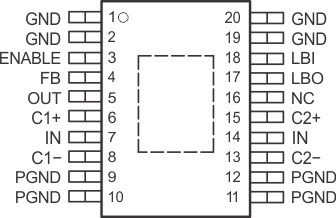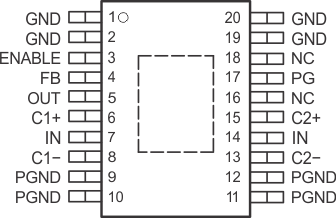SLVS273A February 2000 – November 2015 TPS60140 , TPS60141
PRODUCTION DATA.
- 1 Features
- 2 Applications
- 3 Description
- 4 Revision History
- 5 Description (continued)
- 6 Device Comparison Table
- 7 Pin Configuration and Functions
- 8 Specifications
- 9 Detailed Description
- 10Application and Implementation
- 11Power Supply Recommendations
- 12Layout
- 13Device and Documentation Support
- 14Mechanical, Packaging, and Orderable Information
Package Options
Mechanical Data (Package|Pins)
- PWP|20
Thermal pad, mechanical data (Package|Pins)
- PWP|20
Orderable Information
7 Pin Configuration and Functions
PWP Package (TPS60140)
20 Pin-HTSSOP
Top View

PWP Package (TPS60141)
20 Pin-HTSSOP
Top View

Pin Functions
| PIN | I/O | DESCRIPTION | |
|---|---|---|---|
| NAME | NO. | ||
| C1+ | 6 | — | Positive terminal of the flying capacitor C1 |
| C1− | 8 | — | Negative terminal of the flying capacitor C1 |
| C2+ | 15 | — | Positive terminal of the flying capacitor C2 |
| C2− | 13 | — | Negative terminal of the flying capacitor C2 |
| ENABLE | 3 | I | ENABLE input. Connect ENABLE to IN for normal operation. When ENABLE is a logic low, the device turns off and the supply current decreases to 0.05 µA. The output is disconnected from the input when the device is placed in shutdown. |
| FB | 4 | I | Feedback input. Connect FB to OUT as close to the load as possible to achieve best regulation. A resistive divider is on the chip to match the output voltage to the internal reference voltage of 1.21 V. |
| GND | 1, 2, 19, 20 | — | Ground. Analog ground for internal reference and control circuitry. Connect to PGND through a short trace. |
| IN | 7,14 | I | Supply input. Bypass IN to PGND with capacitor CIN. Connect both IN terminals through a short trace. |
| LBO/PG | 17 | O | Low battery detector output (TPS60140) or power good output (TPS60141). Open-drain output of the low-battery indicator or power-good comparator. It can sink 1 mA. TI recommends a 100-kΩ to 1-MΩ pullup. Leave the terminal unconnected if the low-battery or power-good detector function is not used. |
| LBI/NC | 18 | I | Low battery detector input (TPS60140 only). The voltage applied to this terminal is compared to the internal 1.21-V reference voltage. Connect the terminal to ground if the low-battery comparator is not used. On the TPS60141, this terminal is not connected to the chip and should remain unconnected. |
| NC | 16 | — | Not connected |
| OUT | 5 | O | Regulated 5-V power output. Bypass OUT to PGND with the output filter capacitor COUT. |
| PGND | 9−12 | — | Power ground. The charge-pump current flows through this terminal. Connect all PGND terminals together. |